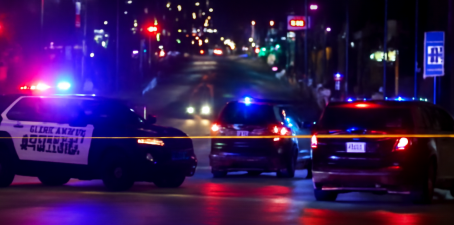The recent outbreak of gunfire inside the Big T nightclub has sent shockwaves through the local community, exposing the harsh reality of violence that continues to plague nightlife venues and urban neighborhoods. The incident, described by witnesses as “crazy” and senseless, underscores the dangerous disregard some individuals have for the safety of others when settling disputes. While the specifics of the event remain under investigation, the ripple effects have already been felt by families, friends, and patrons, who now grapple with fear, trauma, and a call to action.
Located in the heart of the city, Big T has long been a popular destination for nightlife entertainment, drawing crowds seeking music, dancing, and social connection. However, the recent shooting has cast a dark shadow over its reputation, raising questions about security measures and community safety. The shooting inside Big T is not an isolated occurrence but part of a larger pattern of escalating violence that demands urgent attention from law enforcement, policymakers, and community leaders.
The Incident: A Nightmarish Turn Inside Big T
On the night of the incident, what was meant to be a night of celebration and enjoyment turned into chaos as multiple shots were fired inside the club. Eyewitnesses report that the shooting erupted suddenly, leaving many patrons scrambling for safety amid screams and confusion. While authorities have not yet released official casualty numbers, the sense of trauma is palpable. Social media posts capture the raw emotions of those affected, with many expressing disbelief and frustration at the needless violence.
The phrase “Y’all just don’t give a damn about nobody when y’all catch your so-called opp” reflects the deep frustration felt by many, highlighting a broader societal issue where rivalries and disputes escalate into deadly confrontations without regard for innocent bystanders. This mindset of retribution at the expense of community safety is a critical concern that experts believe must be addressed to prevent future tragedies.
Historical Context: Violence in Nightlife Venues
Violence in nightlife establishments is not a new phenomenon. Across urban centers worldwide, nightclubs have often been flashpoints for altercations that spiral into violence. Several factors contribute to this environment, including overcrowding, alcohol and drug use, and the presence of individuals involved in criminal activity or gang affiliations. Nightclubs, by their nature, bring together large groups of people in confined spaces, sometimes with heightened emotions, creating a volatile mix.
Historically, cities have struggled with balancing the economic and cultural benefits of nightlife with the imperative of public safety. The Big T shooting echoes similar incidents that have occurred in other venues, prompting reviews of security protocols, collaboration between club owners and law enforcement, and community outreach programs aimed at violence prevention.
The Community Impact: Fear, Trauma, and the Call for Change
The immediate aftermath of the shooting has left the local community reeling. Families are worried about their loved ones, especially those who frequent the club or live nearby. Many express a sense of helplessness and anxiety, fearful that the violence may continue or escalate. For survivors and witnesses, the psychological trauma can be long-lasting, necessitating access to counseling and support services.
Community leaders have spoken out, calling for increased security measures, improved lighting and surveillance, and enhanced police presence in entertainment districts. There is also a push for programs that address the root causes of violence, such as poverty, lack of education, and social disenfranchisement. The shooting at Big T serves as a stark reminder that these issues are far from resolved.
Expert Perspectives on Gun Violence and Public Safety
Experts in criminology and public health emphasize that addressing gun violence requires a multifaceted approach. Dr. Angela Martinez, a leading researcher on urban violence, notes that “gun violence in public venues is a symptom of broader social challenges, including economic inequality, systemic racism, and the proliferation of firearms.” She advocates for policies that combine enforcement with community engagement and investment in youth programs.
Security consultants stress the importance of proactive measures within clubs, such as thorough screening at entry points, the presence of trained security personnel, and the installation of surveillance technology. Moreover, partnerships between venues and local law enforcement can facilitate rapid responses and deter potential offenders.
Statistical Data on Nightclub Violence
Nationally, data reveals that violence in nightlife settings accounts for a significant portion of urban assaults and homicides. According to the National Crime Victimization Survey, assaults occurring in or around entertainment venues have increased over the past decade, correlating with trends in gun-related violence. This rise calls for a comprehensive review of current policies and preventive strategies.
Future Implications and the Path Forward
The shooting at Big T is a call to action for all stakeholders involved—from club owners and local government to law enforcement and community organizations. Enhancing security protocols, promoting conflict resolution education, and providing alternative outlets for youth engagement are essential steps to reduce the likelihood of such incidents.
Furthermore, increasing public awareness and encouraging community members to report suspicious behavior can empower neighborhoods to take ownership of their safety. The tragic events at Big T must not be allowed to fade into the background but should instead serve as a catalyst for meaningful change.
Conclusion
The shooting inside Big T nightclub is a heartbreaking example of how violence can disrupt lives and fracture communities. As investigations continue and healing begins, it is imperative that efforts are intensified to prevent such senseless acts. Only through collaborative, sustained, and compassionate approaches can the cycle of violence be broken, ensuring that places meant for joy and togetherness remain safe for all.

Leave a Reply